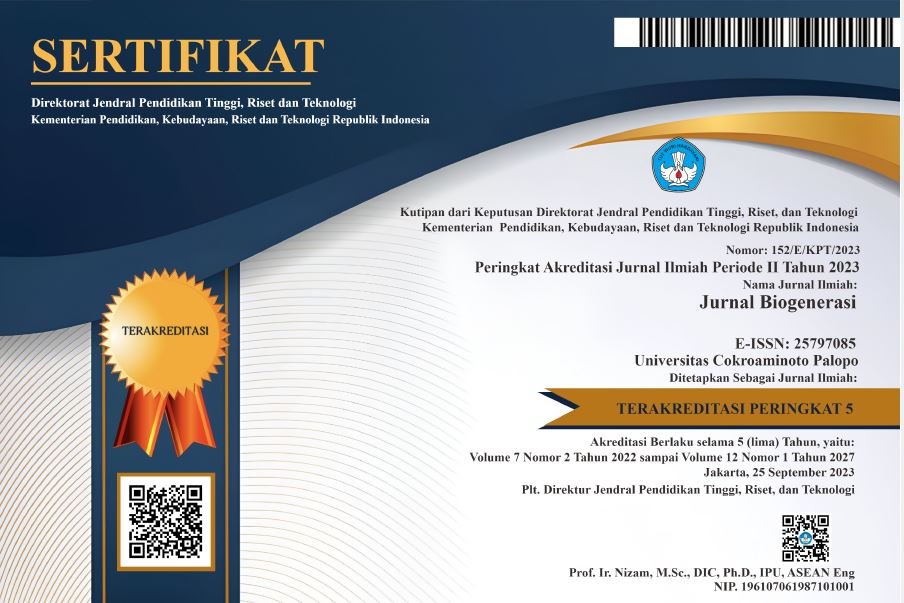TANAMAN TALAS AIR (Colocasia Esculenta (L.) Schott var. aquatilis Hassk) SEBAGAI AGEN FITOREMEDIASI PADA AIR LIMBAH SELOKAN
DOI:
https://doi.org/10.30605/biogenerasi.v9i2.4766Keywords:
phytoremediation, Colocasia esculenta (L.), wastewater, water quality, pollutionAbstract
The aims of this research was to the determine the effectiveness of the taro plant (Colocasia esculenta (L.) Schott var. aquatilis Hassk) as a phytoremediation agent in treating domestic wastewater. Wastewater taken from the sewer in Williem Iskandar, Percut Sei Tuan District was analyzed using parameters such as pH, TDS, temperature and turbidity. The method used is constructed wetland, by placing taro plants in containers filled with sewer water in volumes (2.5 L, 5L, 7.5L and 10 L). Observations were carried out every other day for 6 days. The research results showed that after phytoremediation, the water quality experienced changes, indicating that the taro plant was effective in absorbing pollutants and improving water quality.
Downloads
References
E. Rosita, R. W. Melani, and A. Zulfikar,“Efektivitas Fitoremediasi Kangkung Air(Ipomoea aquatica FORSK) Terhadap Penyerapan Orthopospat pada Detergen Ditinjau dari Detensi
Ghiovani, D., Tangahu, B.V. (2017). Fitur remediasi air yang tercemar limbah laundry dengan menggunakan kayu apu (Pistia stratiotes). Jurnal Teknik ITS. 6(2): 232-236
Haryati, M., T., Purnomo, S. Kuntjoro. (2012). Kemampuan Tanaman Genjer (Limnocharis Flava (L.) Buch.) Menyerap Logam Berat Timbal (Pb) Limbah Cair Kertas pada Biomassa dan Waktu Pemaparan Yang Berbeda. Jurusan FMIPA Universitas Negeri Surabaya. Jurnal Lentera Bio : 1 : 3 : 131–138.
Kustiyaningsih, E., Irawanto,R. (2020). Pengukuran Total Dissolved Solid (TDS) Dalam Fitoremediasi Deterjen Dengan Tumbuhan Sagittaria lanciafolia. Jurnal Tanah dan Sumberdaya Lahan. 7(1): 143-148
Mulia. R. M. (2005). Pengantar Kesehatan Lingkungan. Edisi pertama. Yogyakarta: Graha Ilmu.
Munthe,N.A., Najamuddin, A., Elvince, R. Jurnal of tropical Fisheries.(2021). Efektivitas tumbuhan kangkung air (Ipomoea aquatica Forsk) Dalam Menurunkan Limbah Penatu. Jurnal Of tropical Fisheries. 16(1):1-8
Nono,K.M., Amalo, D , Bakok.A. (2020). Pengaruh tumbuhan talas (Colocasia esculenta (L.) Schott bar. aquatilis Hassk) sebagai fitur remediasi terhadap kualitas air limbah laundry. Jurnal Biotropikal Sains. 17(2): 37-47
Oktavia, Z., N. A. Y. D. Budiyono. 2016. Pengaruh Variasi Lama Kontak Fitoremediasi Tanaman Kiambang (Salvinia molesta) Terhadap Kadar Kadmium (Cd) Pada Limbah Cair Home Industry Batik “X” Magelang. Jurnal Kesehatan Masyarakat : 4 : 5 : 238-246.
Raissa, D. G., Tangahu, B.V. 2017. Fitoremediasi Air yang Tercemar Limbah Laundry dengan Menggunakan Kayu apu (Pistia stratiotes). Jurnal Teknik ITS, 6(2):232-236.
Sudiro dan Agnes, T.A. 2013. Kajian efektifitas tanaman air Lemna minor dan Hydrilla verticillata dalam mereduksi BOD dan COD sebagai upaya perbaikan kualitas limbah cair industri tahu. Jurnal Spectra, Jurusan Teknik Lingkungan Institut Teknologi Nasional, Malang.
Sumiyati, S., Sutrisno,E., Sudarno., Wicaksono, F. (2023). Pengolahan air limbah domestik dengan teknologi hybrid bio reaktor biofilm-fitoremediasi. Jurnal Ilmu Lingkungan. 21(2): 403-407
Suriawira, U. 2005. Mikrobiologi Dasar. Papas Sinar Sinanti, Jakarta.
Suyasa, I. W. B., Dwijani, W. (2007). Kemampuan Sistem Saringan Pasir Tanaman Menurunkan Nilai BOD dan COD Air Tercemar Limbah Pencelupan. Jurusan Kimia FMIPA Universitas Udayana. Ecotrophic: 2 : 1 : 1-7.
Suyasa, W. B. 2015. Pencemaran Air Dan Pengolahan Air Limbah. Bali: Udayana University Press.
Tanjung, R. E., Fahruddin, F., dan Samawi, M. F., (2019). Phytoremediation Relationship of Lead (Pb) by Eichhornia crassipes on pH, BOD and COD in Groundwater. Journal of Physics: Conference Series. 1341(2): 1-6.
Ulfah, M., Endah Rita Sulistya Dewi. (2015). Evaluasi Fitoremediasi Pencemaran Logam Berat di Tanah TPA. Seminar Nasional Hasil Penelitian (SNHP-V), LPPM. Universitas PGRI Semarang (21 November).
Wibowo, K., Komarawidjaja, W. (2012). Uji Tanaman Talas ( Colocasia esculenta) Sebagai Agen Fitoremediasi Air Sungai Cikapundung. Jurnal Tekling. 13 (3): 283-290.
Yanti, F., Simanjuntak,H. (2024). Fitoremediasi Posfat menggunakan Tanaman Eceng gondok pada limbah cair domestik. Jurnal PENDIPA. 8(2):217-222
Downloads
Published
How to Cite
Issue
Section
License
In submitting the manuscript to the journal, the authors certify that:
- They are authorized by their co-authors to enter into these arrangements.
- The work described has not been formally published before, except in the form of an abstract or as part of a published lecture, review, thesis, or overlay journal.
- That it is not under consideration for publication elsewhere,
- That its publication has been approved by all the author(s) and by the responsible authorities – tacitly or explicitly – of the institutes where the work has been carried out.
- They secure the right to reproduce any material that has already been published or copyrighted elsewhere.
- They agree to the following license and copyright agreement.
License and Copyright Agreement
Authors who publish with this journal agree to the following terms:
- Authors retain copyright and grant the journal right of first publication with the work simultaneously licensed under Creative Commons Attribution License (CC BY 4.0) that allows others to share the work with an acknowledgment of the work's authorship and initial publication in this journal.
- Authors are able to enter into separate, additional contractual arrangements for the non-exclusive distribution of the journal's published version of the work (e.g., post it to an institutional repository or publish it in a book), with an acknowledgment of its initial publication in this journal.
- Authors are permitted and encouraged to post their work online (e.g., in institutional repositories or on their website) prior to and during the submission process, as it can lead to productive exchanges, as well as earlier and greater citation of published work.


.png)

